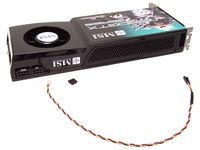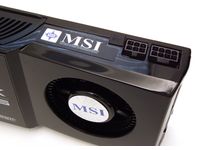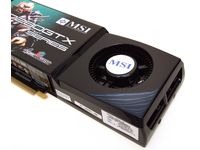The Fastest 3D Cards Go Head-To-Head
GeForce GTX 280 Superclocked
The GTX 280 is fitted with 1,024 MB of GDDR3 RAM (on a 512-bit bus) and supports DirectX 10. The overclocked MSI card is available in two versions. The default runs at 602 MHz for the GPU, 1,296 MHz for the shaders and 2,214 MHz for the memory. The overclocked version from MSI uses 650, 1,296 and 2,300 MHz respectively. And the superclocked version we’re testing uses 700, 1,400 and 2,300 MHz clock speeds. The overclocking improves frame rates in Mass Effect (UT3 Engine) at 1920x1200 pixels with anti-aliasing by 16%. If you take the average of all games in the benchmark suite, you get 5.8%—the best value of the tested overclocked models from MSI.
In terms of overall performance, the GeForce GTX 280 is the fastest card in the test, able to convincingly distance itself from AMD’s competition. It came in first place for five of the six test resolutions. Between the GeForce GTX 260 and GTX 280, the overall performance only shows a difference of 8.7%, which hardly warrants a cost of almost $150 more. The pressure from the competing Radeon HD 4870 pushed the initial price of the GTX 280 down from $649 to $420.
Although the GTX 280 at 11” (27 cm) is the same size as the GTX 260, and it uses higher clock rates, it isn’t much louder. In 2D mode, the temperature rises to 53 degrees Celsius (the GTX 260 goes to 49 degrees), but the fan only generates 37.7 dB(A) whereas the GTX 260 comes in at 38.1 dB(A). Problems with overly aggressive fan speeds in desktop mode do not occur. As long as the graphics chip (GPU) is cooled, the fan remains quiet. In 3D mode, the GTX 280 screams at 54.7 dB(A)— louder than the GTX 260. But it only hits an 85 degree Celsius maximum temperature (the GTX 260 reaches 105 degrees).
The GTX 280 clocks lower in 2D mode, which makes it even more economical than the HD 4850 from AMD. As soon as the GTX 280 comes out of 3D mode it switches to its low power 3D profile (GPU at 400 MHz, shaders at 800 MHz, and memory running at 600 MHz), which draws 130 watts of power (for the entire system). After a few seconds at idle, the clock rate is lowered into 2D mode (GPU at 300 MHz, shaders at 600 MHz, memory at 200 MHz), and overall consumption falls to 117 watts. Under full load, the GeForce GTX 280 consumed 352 watts. A branded power supply rated at 290 to 330 watts with 24 to 28 A on the 12 volt rail should be sufficient for a standard system.












Get Tom's Hardware's best news and in-depth reviews, straight to your inbox.
Current page: GeForce GTX 280 Superclocked
Prev Page SLI With GeForce GTX 260 OC Next Page SLI With GeForce GTX 280 Superclocked-
San Pedro Looks like the results for SLI and Crossfire were switched with the single card results. . .Reply -
Duncan NZ Not a bad article, really comprehensive.Reply
My one complaint? Why use that CPU when you know that the test cards are going to max it out? Why not a quad core OC'ed to 4GHz? It'd give far more meaning to the SLI results. We don't want results that we can duplicate at home, we want results that show what these cards can do. Its a GPU card comparason, not a complain about not having a powerful enough CPU story.
Oh? And please get a native english speaker to give it the once over for spelling and grammar errors, although this one had far less then many articles posted lately. -
Lightnix It'd be a good article if you'd used a powerful enough CPU and up to date Radeon drivers (considering we're now up to 8.8 now), I mean are those even the 'hotfix' 8.6's or just the vanilla drivers?Reply -
elbert Version AMD Catalyst 8.6? Why not just say i'm using ATI drivers with little to no optimizations for the 4800's. This is why the CF benchmarks tanked.Reply -
at 1280, all of the highend cards were CPU limited. at that resolution, you need a 3.2-3.4 c2d to feed a 3870... this article had so much potential, and yet... so much work, so much testing, fast for nothing, because most of the results are very cpu limited (except 1920@AA).Reply
-
wahdangun WTF, hd4850 SHOULD be a lot faster than 9600 GT and 8800 GT even tough they have 1Gig of ramReply -
mjam No 4870X2 and 1920 X 1200 max resolution tested. How about finishing the good start of an article with the rest of it...Reply -
I agree, the 4870 X2 should have been in there and should have used the updated drivers. Good article but I think you fell short on finishing it.Reply
-
@pulasky - Rage much? It's called driver issues you dumbass. Some games are more optimised for multicard setups than others, and even then some favour SLi to Crossfire. And if you actually READ the article rather than let your shrinken libido get the better of you, you'll find that Crossfire does indeed work in CoD4.Reply
Remember, the more you know.
